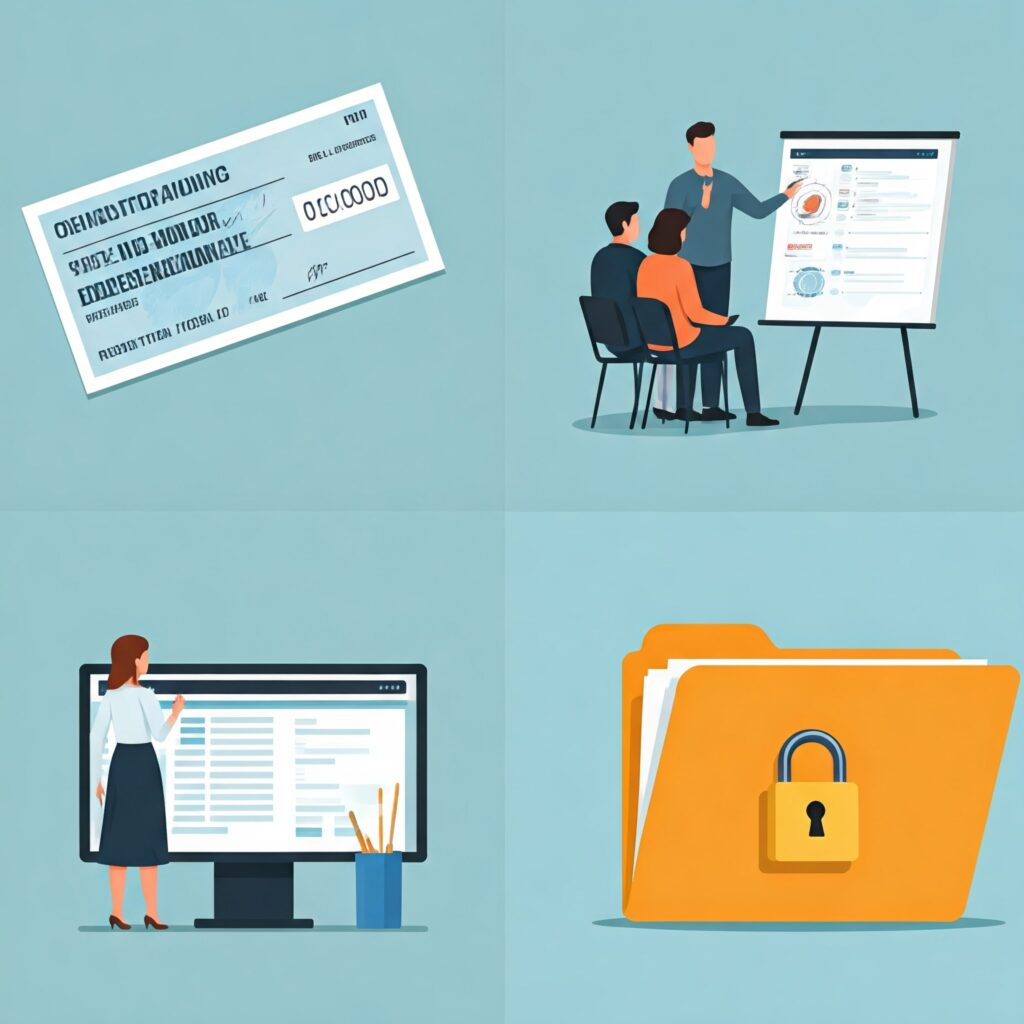Counterfeit checks remain a persistent threat in the modern financial landscape. As technology advances, so do the methods employed by fraudsters to replicate legitimate checks with deceptive accuracy. In 2025, proactive measures are crucial to protect individuals and businesses from falling victim to this sophisticated form of financial crime. This article will explore key prevention strategies and provide a comprehensive understanding of this evolving challenge.
Understanding the Evolving Threat

The landscape of check fraud is constantly evolving, driven by advancements in technology and the ingenuity of fraudsters. To effectively combat this threat, it’s crucial to understand the various methods employed to create and utilize counterfeit checks. Here’s a deeper dive into the evolving threat:
1. Sophisticated Printing Technology
- High-Resolution Reproduction: Modern printers and scanners offer exceptional resolution and color accuracy, enabling fraudsters to replicate intricate check designs, including logos, watermarks, and microprinting, with alarming precision.
- Access to Specialized Equipment: The availability of affordable, high-quality printing equipment makes it easier for criminals to produce counterfeit checks without requiring specialized printing presses or expertise.
- Digital Templates and Software: Fraudsters often utilize digital templates and specialized software to create realistic-looking checks, further enhancing the quality and speed of production.
2. Check Washing
- Chemical Alteration: This technique involves using chemical solvents, such as acetone or bleach, to erase or alter the information on a legitimate check. The original payee name, amount, or other details can be removed and replaced with fraudulent information.
- Sophisticated Solvents: Fraudsters are increasingly using more sophisticated solvents that are less likely to damage the check paper or leave visible traces of tampering.
- Targeting Specific Checks: Criminals often target checks printed on standard paper stock, as these are more susceptible to chemical alteration compared to checks with security features or special coatings.
3. Digital Alteration
- Image Manipulation: Advanced image editing software allows fraudsters to manipulate check images, altering critical data such as account numbers, routing numbers, signatures, and payee information.
- Remote Deposit Capture (RDC) Vulnerability: The increasing use of RDC systems, where checks are scanned and transmitted electronically, presents new opportunities for digital alteration. Fraudsters can intercept check images during transmission or alter stored images before they are processed.
- Creation of “Frankenstein Checks”: This involves combining elements from different checks or using stolen check information to create entirely new counterfeit checks.
4. Other Emerging Threats
- Counterfeit Check Scams: These scams often involve online marketplaces or classified ads, where fraudsters offer goods or services and request payment via check. The checks are often counterfeit, and the victims lose their money when the checks bounce.
- Business Email Compromise (BEC) Schemes: In BEC scams, fraudsters impersonate business executives or vendors and instruct employees to make payments to fraudulent accounts using counterfeit checks.
- The use of AI: With the development of AI image generation and deepfake technology, the possibility of creating highly realistic counterfeit checks increases.
Prevention Strategies for 2025

- Enhanced Security Features:
- Check 21 Compliance: Adhere to Check 21 regulations, which mandate the acceptance of electronic check images. This reduces reliance on physical checks, minimizing the risk of counterfeiting.
- Advanced Security Printing: Utilize checks with intricate security features like microprinting, holograms, and watermarks that are difficult to replicate.
- Check Fraud Detection Software: Implement software that analyzes check images for anomalies, identifying potential counterfeits based on patterns and deviations from expected features.
- Employee Training and Awareness:
- Regular Training: Conduct regular training sessions for employees who handle checks, emphasizing the importance of vigilance and the latest counterfeit detection techniques.
- Red Flag Recognition: Educate employees on identifying red flags, such as unusual check appearances, discrepancies in information, or suspicious behavior from customers.
- Reporting Procedures: Establish clear procedures for reporting suspected counterfeit checks to appropriate authorities, such as law enforcement and financial institutions.
- Technological Advancements:
- Remote Deposit Capture (RDC): Encourage the use of RDC systems, which allow businesses to electronically deposit checks directly from their premises. This eliminates the need to physically transport checks, reducing the risk of theft or interception.
- Biometric Authentication: Explore the use of biometric authentication methods, such as fingerprint or facial recognition, to verify check transactions and enhance security.
- Blockchain Technology: Investigate the potential of blockchain technology to track check transactions and enhance transparency, making it more difficult to manipulate or counterfeit checks.
Real-World Example: The “Check Washing” Scam
In a recent case, a fraudster obtained a legitimate check and used a chemical solvent to wash away the original payee and amount. The fraudster then rewrote the check, making it payable to themselves for a significantly larger amount. This sophisticated technique highlights the evolving nature of check fraud and the importance of robust prevention measures.
Check washing is a form of fraud where criminals alter legitimate checks to their benefit. They typically acquire a check, often through mail theft, and use chemicals like acetone or bleach to erase the ink containing the payee’s name and the amount. They then rewrite the check to themselves or an accomplice, often for a much larger sum. Here are some more detailed examples and descriptions:
Example 1: The Stolen Mail Scheme
- Theft: A fraudster targets residential mailboxes, stealing mail containing outgoing checks.
- Washing: The criminal uses a common household chemical, such as nail polish remover (acetone), to carefully erase the ink on the stolen check, removing the original payee and amount.
- Rewriting: The fraudster then uses a pen or printer to rewrite the check, making it payable to themselves or a fictitious name for a significantly higher amount.
- Cashing: The altered check is then deposited into a bank account controlled by the fraudster, who quickly withdraws the funds before the fraud is detected.
Example 2: The Business Check Targeting
- Infiltration: A fraudster might gain temporary access to a business’s outgoing mail or internal mail system.
- Selection: The criminal selects a recently written check, often one for a substantial amount, to maximize their potential gain.
- Sophisticated Washing: In some cases, fraudsters use more specialized solvents that are less likely to damage the check paper or leave visible traces of tampering. This makes the alteration more difficult to detect.
- Collaboration: The fraudster may work with an accomplice who opens a bank account under a false identity to deposit the altered check.
Example 3: The Online Marketplace Scam
- Online Interaction: A fraudster poses as a buyer on an online marketplace, offering to purchase an item from a seller.
- Check as Payment: The fraudster sends a check as payment, but the check has been washed and altered to reflect a much higher amount than the agreed-upon price.
- Overpayment Ruse: The fraudster then contacts the seller, claiming they accidentally overpaid and requesting a refund for the difference.
- Loss for the Seller: The seller, unaware of the fraud, sends the refund. However, the original check bounces, leaving the seller with a financial loss.
10 Key Questions and Answers
- What are the most common methods used to counterfeit checks?
- Answer: Sophisticated printing, check washing, and digital alteration are among the most prevalent techniques.
- How can businesses reduce their reliance on physical checks?
- Answer: By embracing Check 21 regulations and encouraging the use of electronic check imaging and RDC systems.
- What role does employee training play in preventing check fraud?
- Answer: Educating employees about red flags, detection techniques, and reporting procedures is crucial.
- What are some advanced security features incorporated into modern checks?
- Answer: Microprinting, holograms, watermarks, and specialized inks are examples of such features.
- How can technology help in detecting counterfeit checks?
- Answer: Through the use of check fraud detection software, biometric authentication, and blockchain technology.
- What is the significance of Check 21 regulations?
- Answer: Check 21 mandates the acceptance of electronic check images, reducing reliance on physical checks and minimizing the risk of counterfeiting.
- What are the potential benefits of using RDC systems?
- Answer: RDC systems enhance security by eliminating the need to physically transport checks.
- How can businesses stay informed about the latest check fraud trends?
- Answer: By staying connected with industry publications, attending relevant seminars, and collaborating with financial institutions.
- What are the potential consequences of accepting a counterfeit check?
- Answer: Businesses may incur financial losses and face reputational damage.
- What steps should businesses take if they suspect a counterfeit check?
- Answer: Immediately report the incident to law enforcement and their financial institution, and cooperate fully with the investigation.
Conclusion
In the evolving landscape of financial crime, proactive measures are essential to combat the threat of counterfeit checks. By implementing a multi-layered approach that combines enhanced security features, employee training, and technological advancements, businesses and individuals can significantly reduce their vulnerability to this sophisticated form of fraud. Sources and related content















